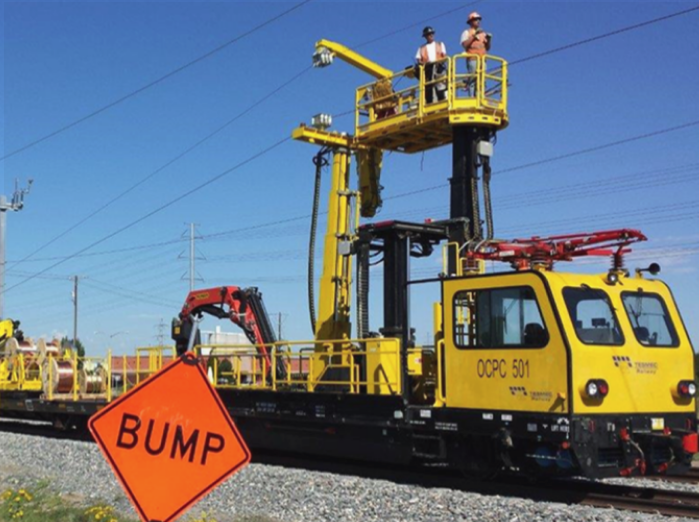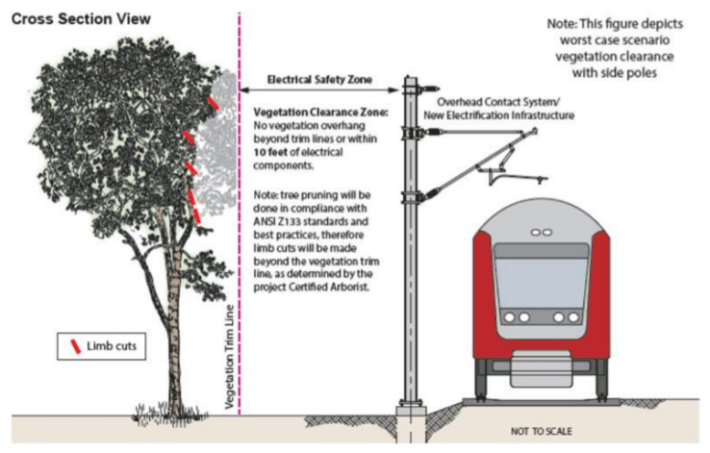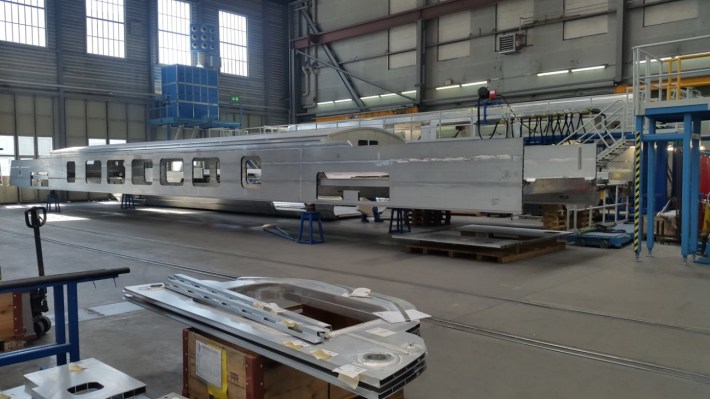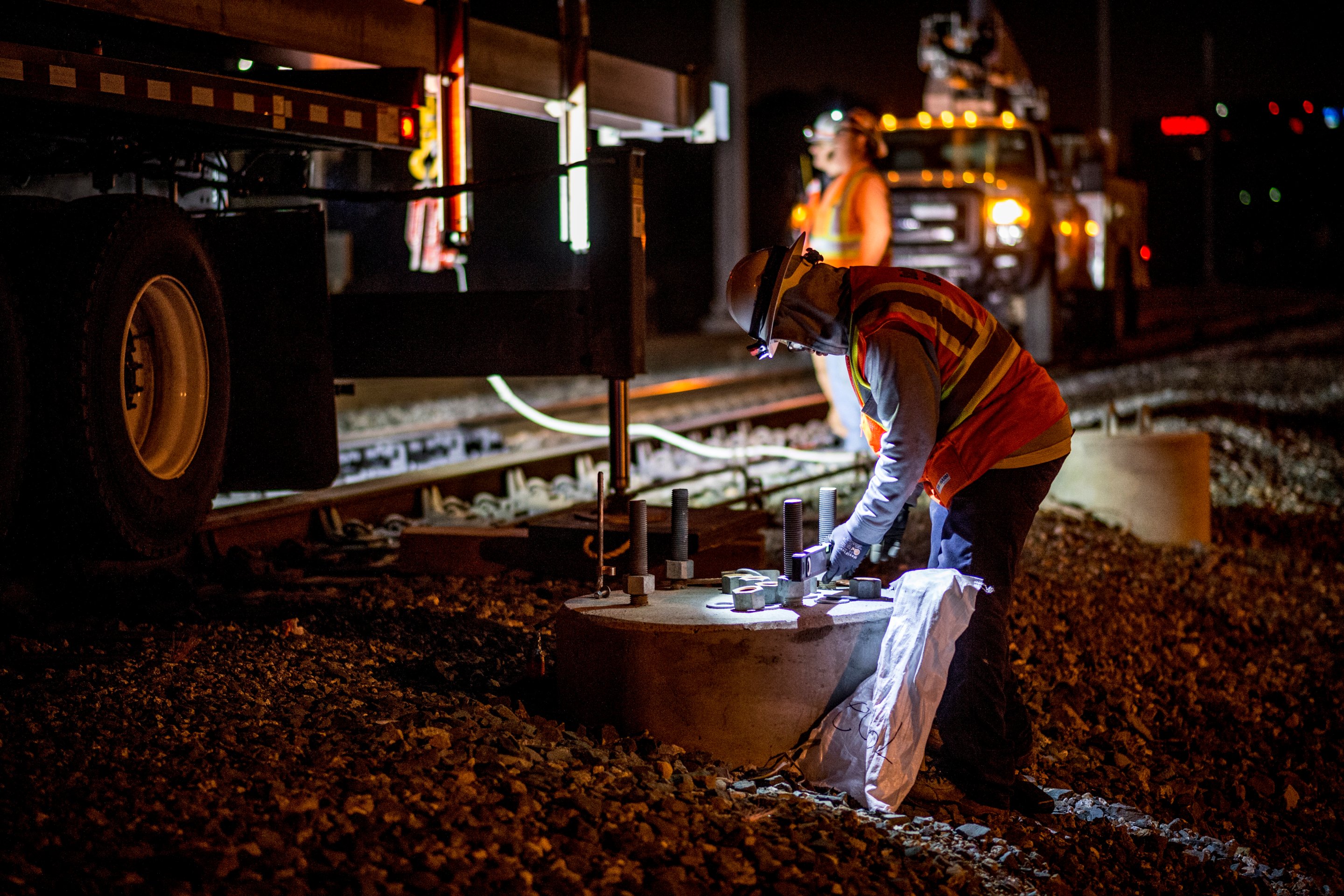Note: GJEL Accident Attorneys regularly sponsors coverage on Streetsblog San Francisco and Streetsblog California. Unless noted in the story, GJEL Accident Attorneys is not consulted for the content or editorial direction of the sponsored content.
Three-thousand steel poles, ten new electrical power facilities, and enough conduit to span 51 miles of tracks are just part of what's involved in Caltrain's $2 billion electrification project. "We're also going to have to replace 52 trees," explained Greg Parks, a consultant working with Caltrain, during a presentation Tuesday night at the Mission Creek Senior Community near Caltrain's King Street terminus in San Francisco. The presentation, which was given to some 30 local residents, gave an update on the project and explained potential construction impacts for people who live along the tracks in San Francisco.
Currently, steel poles are installed along the tracks in San Bruno, Millbrae, and South San Francisco. After large clusters of poles are put in, work trains will go down the tracks at night and string overhead wire, as pictured here:

In the four tunnels that Caltrain runs in through San Francisco, the wire will be attached to beams suspended from the ceiling and sides of the tunnels. In October, the agency will start literally notching the concrete inside the tunnels to hold the beams and anchor bolts. "That will require shutting down rail service north of Bayshore Station and using substitute buses" on the weekends for about six months, said Parks. Work inside the tunnels, and the weekend service disruptions between San Francisco and Bayshore Station, are expected to last through March 17 of 2019. Peak weekday service, fortunately, will continue as normal throughout all phases of the project.
As mentioned, some trees along the route have to go--and many others will have to be pruned--to create a safe zone between trees and the overhead wire, which, once the new electric trains begin testing, will carry 25,000 volts. In San Francisco, there will be 24 trees removed in total, some on the Caltrain right of way, and some on adjoining public property. But thankfully none on private property, explained Parks.

The railroad also has 96 electric trains on order and under construction by Stadler US, based in Salt Lake City. The new rail cars, based on an off-the-shelf, European design, are self-propelled "electric multiple units." That means each car has its own motive power--just like a BART train. That will make the trains far more reliable, since multiple motors can fail before the train has to be taken out of service. They also will have a much better power-to-weight ratio, which will enable the trains to go from a dead stop to full speed in a fraction of the time it takes Caltrain's current fleet of diesel-hauled trains. To put that in perspective, a Baby Bullet express train from San Jose to San Francisco that currently takes 60 minutes, will take 45 minutes with the new trains. The extra acceleration will also enable more trains per hour and higher capacity.

For San Francisco residents near the right of way, the takeaway is the trains will be much quieter--and won't belch diesel smoke (here's some video of the same type of EMU's Caltrain has on order running in Switzerland, to get an idea of what they will look and sound like).
Acceleration will be better, but the top speed of the new electric trains will be limited to 79 mph, which is the same as the current fleet. In addition to electrifying from Gilroy to Tamien, the California High-speed rail project will do additional trackwork--including widening some of the curves, to allow faster speeds. Caltrain will then be able to increase its top speed to over 100 mph. A representative from Balfour Beatty said the electric traction system, poles and wires they are installing are all being designed to facilitate the higher speeds with only minimal modification. For example, on curves the electrical infrastructure will have enough clearance so the tracks can be rejiggered for higher speeds without having to relocate any poles or foundations (although the overhead wire will need some adjustments).
Caltrain representatives said they are building a test track between San Jose and Santa Clara so they can start testing the new EMU trainsets as soon as the first cars arrive, sometime next year. The first electric passenger service on is expected to start in 2022.
One audience member who lives near the Caltrain right of way said she will be happy to see an end to diesel trains belching out black smoke. Another audience member asked when electrified Caltrain will get to downtown San Francisco, into the newly completed Salesforce Transit Center. Caltrain officials explained that's a separate project, but, as previously reported, the earliest date for that is 2026.
Caltrain has posted more information on the Calmod website, including this time-lapse video of an electrification pole getting installed:





